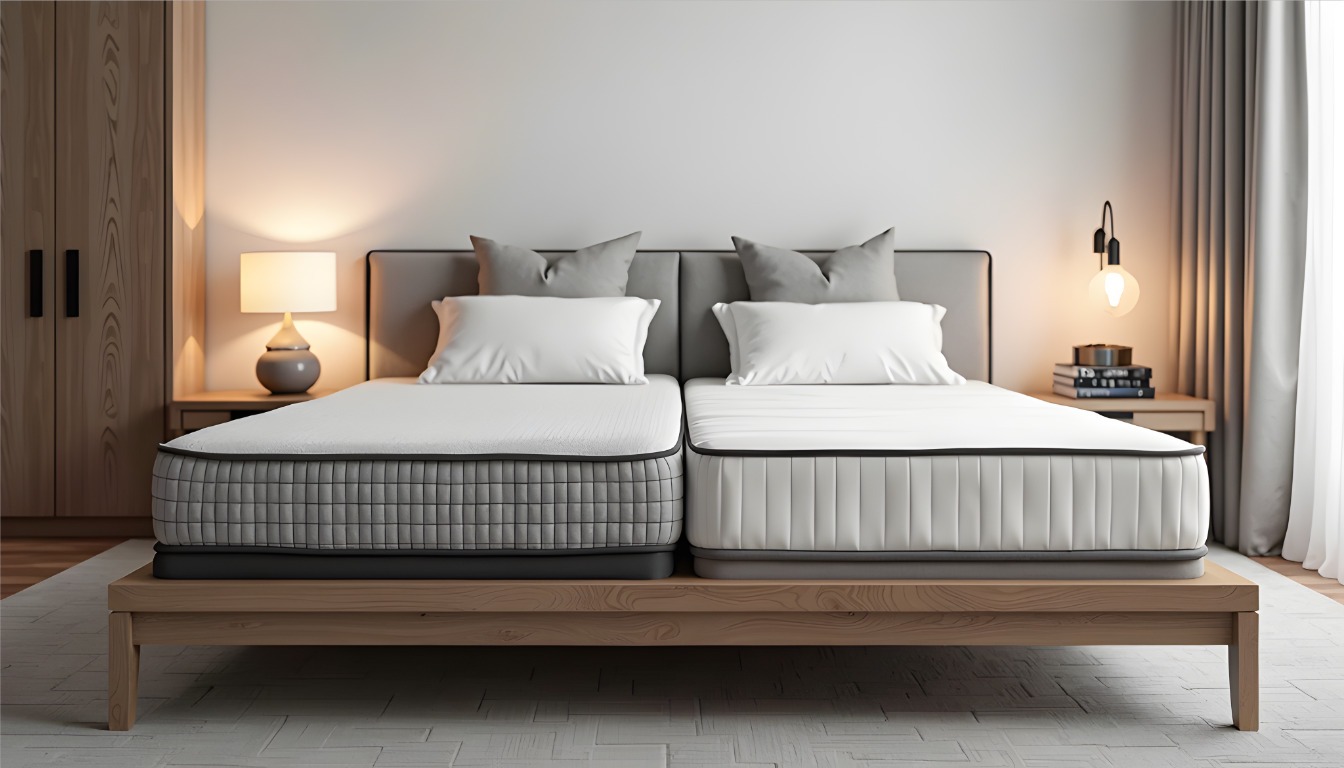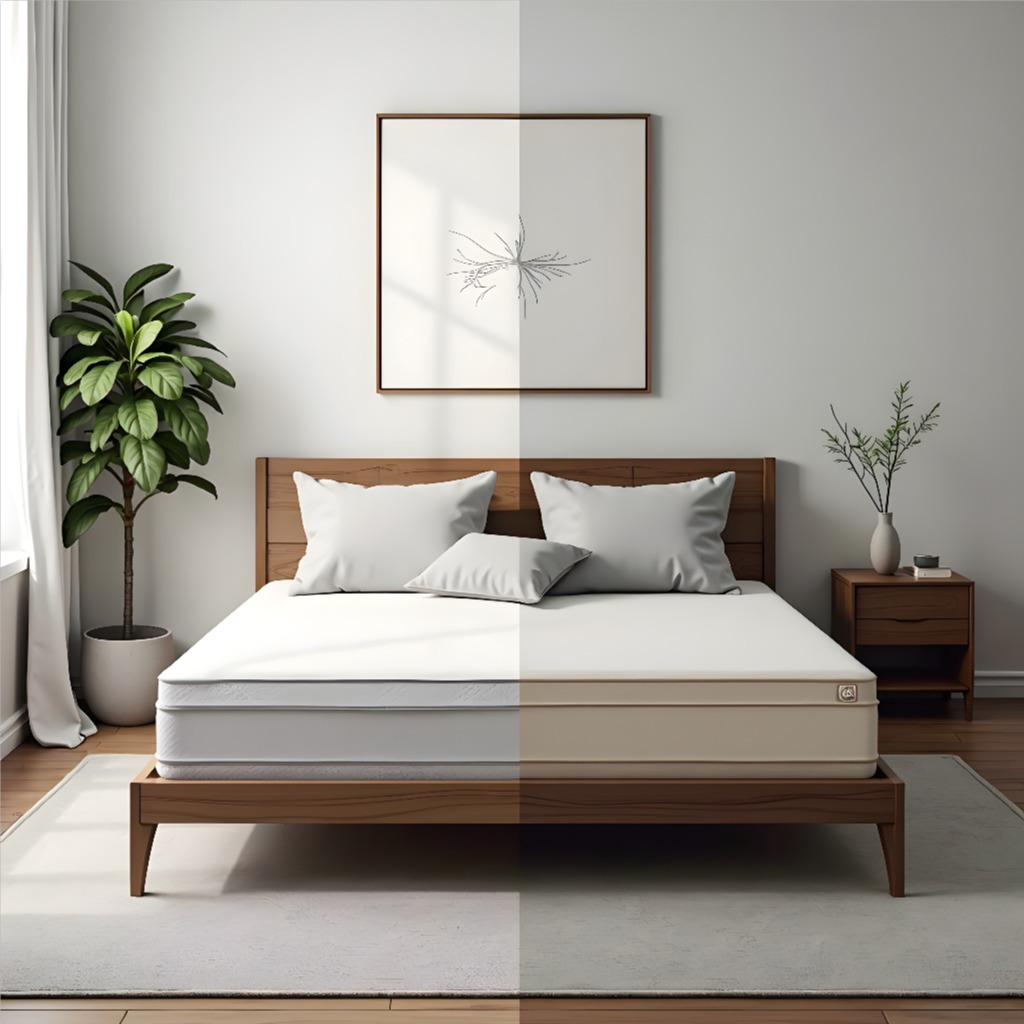
Box Spring vs Foundation: When shopping for a new bed, one of the very first choices you’ll face is whether to pick a box spring or a structure. In this article, we’ll break down the distinctions between a box spring and a structure, helping you identify which is the best choice for your mattress.
To find The Best Box Springs, Click Here.
Defining Box Springs and Foundations
What is a Box Spring?
A box spring is a conventional mattress support group that includes a wood or metal frame with a spring core, typically wrapped in material. It is designed to provide additional bounce and support for innerspring mattresses, assisting in dispersing weight equally across the bed and tear and lowering the wear on your mattress.
- Queen Box Spring: A box spring designed for a queen bed mattress, typically measuring 60 inches by 80 inches.
- King Size Box Spring: A bigger version, generally divided into two different pieces to support a king bed mattress.
What is a Foundation?
A foundation is a flat, strong base developed to support your bed mattress. Unlike a box spring, a structure does not include springs but rather consists of a slatted or strong platform made from wood or metal. It offers a durable, flat surface area for all types of mattresses, including memory foam and hybrid models.
- Foundation for Memory Foam Mattress: A foundation made of solid wood or metal slats that offer consistent support to memory foam bed mattresses, which do not need the extra bounce that a box spring offers.
Secret Differences Between a Box Spring and a Foundation
1. Building and Design
Box Springs: Box springs are built with a spring core inside a fabric-covered frame, using a little bounce and flexibility. This makes them ideal for innerspring mattresses that require additional support and provide.
Structures: Foundations are strong, flat, and generally feature wood or metal slats. The lack of springs suggests they don’t add any extra bounce. They provide a tough, firm base, especially useful for mattresses like memory foam or hybrid bed mattresses that need flat, even support.
2. Viability for Mattress Types
Box Springs: Best suited for innerspring bed mattress, as the bounce and offer from the springs complement the innerspring system, helping it keep its shape and providing extra comfort.
Foundations: Ideal for memory latex, foam, and hybrid bed mattresses, which don’t need the extra bounce of a box spring. A foundation provides this bed mattress to the company, even the support they require for optimum comfort.
3. Height and Design Flexibility
Box Springs: Typically taller, contributing to a greater general bed height. If you want a taller bed, a queen box spring or king-size box spring may be an excellent option.
Structures: Usually lower in height, using a sleeker, more contemporary appearance. This is ideal for those who prefer a lower bed profile without sacrificing mattress support.
When to Choose a Box Spring Over a Foundation

When to Choose a Box Spring
Innerspring Mattresses: If you have an innerspring bed mattress, a box spring is the very best choice. The spring assistance assists the soak-up effect and uniformly distributes weight across the mattress.
Standard Look and Feel: If you choose a more bouncy or standard feel for your bed, a box spring might be the method to go. The bounce it offers can contribute to a more luxurious feel, which some sleepers prefer.
When to Choose a Foundation
Memory Foam and Hybrid Mattresses: Memory foam bed mattresses need a flat, firm surface for ideal assistance. A foundation for a memory foam mattress is the very best option to avoid sagging or unequal support, as foam mattresses require a strong, even surface area to keep their integrity.
Sleeker Design: If you’re opting for a modern, minimalistic design, foundations usually use a cleaner, lower-profile appearance that can complement modern bedroom design.
Pros and Cons of Box Springs and Foundations
Box Spring vs Foundation: Advantages and disadvantages of Box Springs
Pros
- Great for Innerspring Mattresses: Box springs are developed for innerspring mattresses, offering extra assistance and preserving bed mattress integrity.
- Height: They use additional height to your bed, which can make it much easier to get in and out of bed.
- Classic Look: For those who take pleasure in a more traditional visual, a box spring offers that classic, elevated appearance.
Cons
- Not Ideal for Memory Foam: Box springs are not suggested for memory foam or hybrid bed mattresses, as they don’t provide a flat, helpful surface area.
- Bulky: Box springs can be large and take up more space under your bed, which may be less desirable for those with limited room.
Advantages and Disadvantages of Foundations
Pros
- Ideal for Memory Foam and Hybrid Mattresses: Foundations offer even, strong support for foam and hybrid mattresses, which is important for their durability.
- Sleek Design: They use a lower profile, making them perfect for minimalist or modern-day bedroom setups.
- Durability: Foundations are usually longer-lasting and durable compared to box springs, specifically for mattresses that require a firm, flat base.
Cons
- Limited Bounce: Foundations lack the bounce of box springs, which some individuals might miss, particularly those who prefer a springier feel.
- Height: If you choose a higher bed, a structure may not supply the height you’re looking for.
Elements to Consider for Your Mattress and Bed

When choosing between a box spring and a foundation, here are some factors to keep in mind:
1. Mattress Type
The first consideration is always the type of bed mattress you have. Innerspring bed mattress works best with a queen box spring or economy-size box spring. At the same time, structures support memory foam mattresses and hybrid bed mattresses.
2. Desired Bed Height
A box spring will assist you in attaining that if you want a taller bed. Nevertheless, if you choose a smooth, low-profile bed, a structure is the better choice.
3. Aesthetic Preferences
Think about the total feel and look you want for your bedroom. Box springs provide a more traditional ambience, while foundations provide a more contemporary aesthetic.
4. Budget plan
Box springs are less expensive compared to structures, which is an important consideration if you’re working within a budget.
Conclusion: Box Spring vs Foundation
Both box springs and foundations provide important advantages depending on your specific needs. A box spring is the finest option for included support and bounce if you have an innerspring mattress. For memory foam or hybrid mattresses, a structure is a perfect choice for the company, even assistance. Consider your mattress type, bed height choices, and aesthetic requirements to make the best option for your sleep system.
When shopping for a brand-new bed, one of the very first choices you’ll deal with is whether to choose a box spring or a structure. In this short article, we’ll break down the differences between a box spring and a structure, helping you figure out which is the best choice for your mattress. Unlike a box spring, a structure does not consist of springs but rather consists of a strong or slatted platform made of wood or metal. Both box springs and structures provide important benefits depending on your particular needs. If you have an innerspring mattress, a box spring is the finest choice for added support and bounce.



Leave a Reply